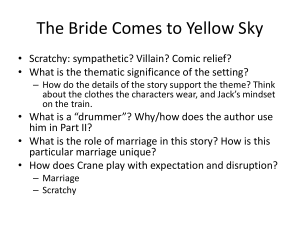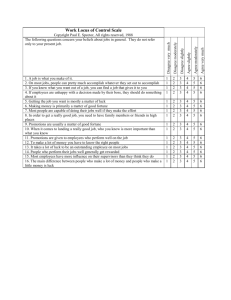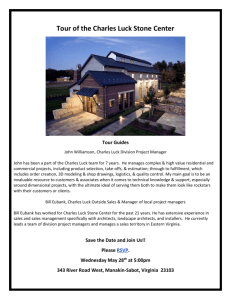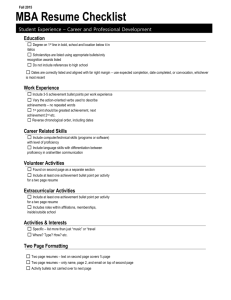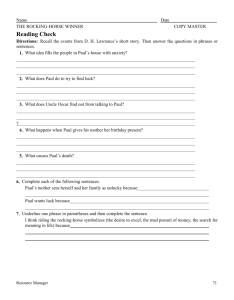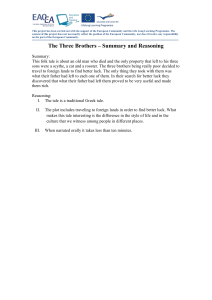Great By Choice - Jubelirer Results Group
advertisement
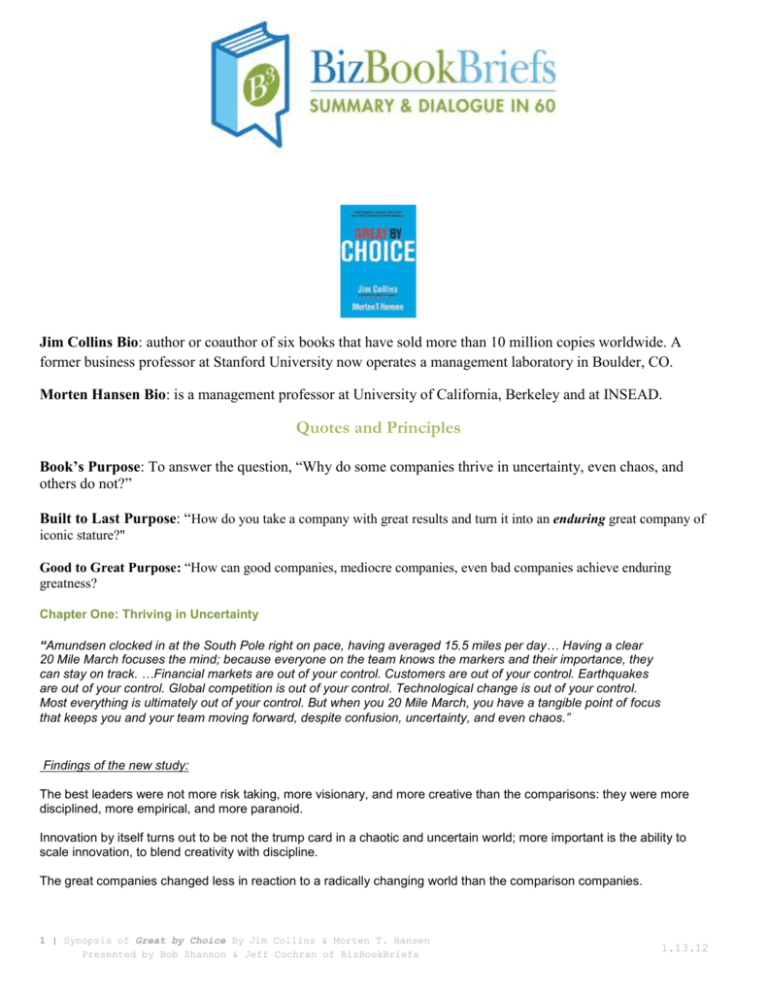
Jim Collins Bio: author or coauthor of six books that have sold more than 10 million copies worldwide. A former business professor at Stanford University now operates a management laboratory in Boulder, CO. Morten Hansen Bio: is a management professor at University of California, Berkeley and at INSEAD. Quotes and Principles Book’s Purpose: To answer the question, “Why do some companies thrive in uncertainty, even chaos, and others do not?” Built to Last Purpose: “How do you take a company with great results and turn it into an enduring great company of iconic stature?" Good to Great Purpose: “How can good companies, mediocre companies, even bad companies achieve enduring greatness? Chapter One: Thriving in Uncertainty “Amundsen clocked in at the South Pole right on pace, having averaged 15.5 miles per day… Having a clear 20 Mile March focuses the mind; because everyone on the team knows the markers and their importance, they can stay on track. …Financial markets are out of your control. Customers are out of your control. Earthquakes are out of your control. Global competition is out of your control. Technological change is out of your control. Most everything is ultimately out of your control. But when you 20 Mile March, you have a tangible point of focus that keeps you and your team moving forward, despite confusion, uncertainty, and even chaos.” Findings of the new study: The best leaders were not more risk taking, more visionary, and more creative than the comparisons: they were more disciplined, more empirical, and more paranoid. Innovation by itself turns out to be not the trump card in a chaotic and uncertain world; more important is the ability to scale innovation, to blend creativity with discipline. The great companies changed less in reaction to a radically changing world than the comparison companies. 1 | Synopsis of Great by Choice By Jim Collins & Morten T. Hansen Presented by Bob Shannon & Jeff Cochran of BizBookBriefs 1.13.12 Context Research was completed in 2002 and the companies chosen where studied from their inception for the most part. Chapter 2….10xers “Are clear eyed and stoic, 10xers accept, without complaint, that they face forces beyond their control, that they cannot accurately predict events, and that nothing is certain; yet they utterly reject the idea that luck, chaos, or any other external factor will determine whether they succeed or fail.” 3 Core Behaviors: Fanatic Discipline: 10xers display extreme consistency of action – consistency with values, goals, performance standards, and methods. They are utterly relentless, monomaniacal, unbending in their focus on their quests. Fanatic discipline often means being a nonconformist. Empirical creativity: When faced with uncertainty, 10xers do not look primarily to other people, conventional wisdom, authority figures, or peers for direction: they look primarily to empirical evidence. They rely on direct observation, practical experimentation, and direct engagement with tangible evidence. 10xers favor empiricism as the foundation for decisive action. Productive paranoia: 10xers maintain hyper vigilance, staying highly attuned to threats and changes in their environment, even when…..especially when…all’s going well. They assume conditions will turn against them, at perhaps the worst possible moment. They channel their fear and worry into action, preparing, developing contingency plans and building large margins of safety. Productive paranoia enables creative action, you are prepared. Key Question: Rank-order the core 10xers behaviors – fanatic discipline, empirical creativity and productive paranoia, from your strongest to your weakest. What can you do to turn your weakest into your strongest? Chapter 3….20 Mile March To 20 Mile March requires hitting specified performance markers with great consistency over a long period of time. It requires two distinct types of discomfort, delivering high performance in difficult times and holding back in good times. A good 20 Mile March has the following seven characteristics: (p. 65) 1. Clear performance markers 2. Self imposed constraints 3. Appropriate to the specific enterprise. 4. Largely within the company’s control to achieve. 5. A proper timeframe…long enough to manage, yet short enough to have teeth. 6. Imposed by the company itself. 7. Achieved with high consistency. Examples: Progressive Insurance: Kept combined ratio below 100% every year, averaging 96% across time. Limited growth to ensure it maintained underwriting standards and hit targets. Stryker: Achieved 20% annual earnings’ growth. Practiced 20 Mile innovation via lots of product iterations and extensions. Held back on growth in good times, which enabled it to weather difficult industry events from 1992 to 1994. 2 | Synopsis of Great by Choice By Jim Collins & Morten T. Hansen Presented by Bob Shannon & Jeff Cochran of BizBookBriefs 1.13.12 Southwest Airlines: Achieved profitability for 30 consecutive years. Turned a profit in 2002 despite aftermath of 9/11. Constrained growth to ensure profitability and preserve culture. A company can always adopt 20 Mile March discipline even if it hasn’t had such discipline earlier in its history (Genentech). 20 Mile Marching were set before these companies became big successes. In addition there’s an inverse relationship between pursuit of maximum growth and 10x success. While comparison companies pressed for maximum growth in robust times, 10xers left growth on the table, always assuming that something would go wrong. Key Question: What is your 20 Mile March, something that you can commit to achieving for 15 to 30 years with as much consistency as Stryker, SW Airlines, Intel and Progressive? Chapter 4….Fire Bullets, Then Cannonballs John Brown at Stryker lived by the mantra that it’s best to be “one fad behind,” never be the first to market, but never last.” Intel’s Andy Grove sought to pattern his company, not after an advanced R & D lab but – of all companies – McDonalds, keeping a burger box with a mock logo, McIntel. Intel #1 core value after 25 years, Discipline. “Amgen’s early days illustrate a key pattern we observed in this study: fire bullets, then cannonballs. First, you fire bullets to see what‘ll work. Then once you have empirical evidence based on bullets, you concentrate your resources and fire a cannonball. After the cannonball hits, you keep 20 Mile Marching to make the most out of your success.” What Makes a Bullet? Can include acquisitions. A bullet is a low cost. Note: the size of a bullet grows as the enterprise grows; a cannonball for a $1MM enterprise might be a bullet for a $1B enterprise. A bullet is low risk. Note: low risk doesn’t mean high probability of success; low risk means that there are minimal consequences if the bullet goes awry or hits nothing. A bullet is low distraction. Note: this means low distraction for the overall enterprise; it may be a high distraction for a few individuals. Uncalibrated cannonball, move without any empirical evidence. PSA versus Southwest Airlines 10xers appear to have no better ability to predict impending changes and events than the comparisons. They aren’t visionary geniuses; they’re empiricists. “The combination of creativity and discipline, translated into the ability to scale innovation with great consistency, better explains some of the greatest success stories… from Intel, to Southwest Airlines, from Amgen’s early years to Apple’s resurgence under Steve Jobs…then the mythology of big-hit, single-step breakthroughs.” Key Question: Which of the following behaviors do your most need to increase? Fire enough bullets? Resisting the temptation to fire uncalibrated cannonballs. Committing, by converting bullets into cannonballs once you have empirical evidence. 3 | Synopsis of Great by Choice By Jim Collins & Morten T. Hansen Presented by Bob Shannon & Jeff Cochran of BizBookBriefs 1.13.12 Chapter 5….Leading Above the Death Line Three core sets of practices, rooted in the research, for leading and building a great enterprise with productive paranoia: 1. Build cash reserves and buffers – oxygen canisters – to prepare for unexpected events and bad luck before the happen. 2. Bound risk – Death Line risk, asymmetric risk, and uncontrollable risk and manage time based risk. 3. Zoom out (big picture), then zoom in, remaining hyper vigilant to sense changing conditions and respond effectively. “10xers remain productively paranoid during good times, recognizing that it’s what they do before the storm comes that matters most. Since it is impossible to consistently predict disruptive events, they systematically build buffers and shock absorbers for dealing with unexpected events. They put into place their extra oxygen canisters long before they’re hit with a storm.” 3 Types of Risk: Death line risk which can kill or severely damage your company. Asymmetrical risk in which the downside dwarfs the upside. Uncontrollable risk which cannot be controlled or managed. When 10xers sense danger, they immediately zoom out to consider how quickly a threat is approaching and whether it calls for a change in plans. Then zoom in, refocusing their energies into executing principles. 10xer teams tended to take their time, to lets events unfold, when the risk profile was changing slowly; yet equally, they prepared to act blindingly fast in the event that the risk profile began to change rapidly. Key Question: Regarding the biggest threats and dangers facing your enterprise, how much time before your risk profile changes? Chapter 6…..SMaC A SMaC recipe is a set of durable operating practices that create a replicable and consistent success formula. The word “SMaC” stands for Specific, Methodical and Consistent. It is clear and concrete, enabling the entire enterprise to unify and organize its efforts, giving clear guidance regarding what to do and not to do. Examples: John Wooden’s “Pyramid for Success”, the US Constitution, Howard Putnam’s recipe for SWA. “Conventional wisdom says that change is hard. But if change is so difficult, why do we see more evidence of radical change in less successful comparison cases? Because change is not the most difficult part. Far more difficult than implementing change is figuring out what works, understanding why it works, grasping when to change, and knowing when not to. 4 | Synopsis of Great by Choice By Jim Collins & Morten T. Hansen Presented by Bob Shannon & Jeff Cochran of BizBookBriefs 1.13.12 We have found in all our research studies that the signature of mediocrity is not an unwillingness to change; the signature of mediocrity is chronic inconsistency.” When to amend your SMaC recipe: (1) exercising empirical creativity, which is more internally driven (fire bullets, then cannonballs) and (2) exercising productive paranoia (zoom in and out), which is more externally driven. 10xers changes their SMaC recipes only 15% (compared to 60% for comparison cases) and lasted over 20 years, despite facing rapid change and unrelenting uncertainty. Key Question: What is your SMaC recipe and does it need amending? Chapter 7…Return on Luck 10x companies did NOT have more good, bad or earlier luck than comparison companies. Good luck does make a great company, but a stroke of extremely bad luck or an extended sequence of bad luck events that create a catastrophic outcome, can terminate the quest. So assume bad luck will happen and prepare ahead of time. “Who luck”, the luck of finding the right mentor, partner, teammate, leader, friend….is one of the most important types of luck. The best way to find a strong current of good luck is to swim with great people and to build deep and enduring relationships with people for whom you’d risk your life and who’d risk their lives for you. “ Key Questions: What significant luck events have your experienced in the last decade? Did you get a high return on luck? Why or why not? What can you do to increase your return on luck? Conclusion: these 10x companies survived and succeeded through extended uncertainty and chaotic periods, because they expected and prepared for it as a natural part of life. They achieved outsized results versus their comparison companies due to the adherence of three behaviors; fanatic discipline, seeking empirical evidence prior to major decisions and were paranoid seeking the next calamity to befall upon them. Lastly they all had Level 5 ambition to be great and were committed to it. 5 | Synopsis of Great by Choice By Jim Collins & Morten T. Hansen Presented by Bob Shannon & Jeff Cochran of BizBookBriefs 1.13.12
